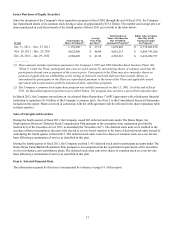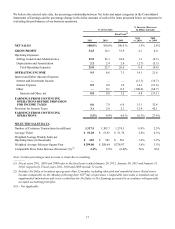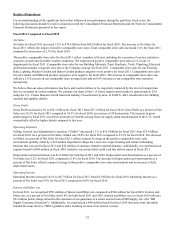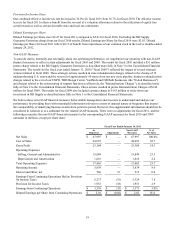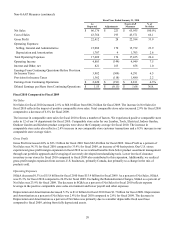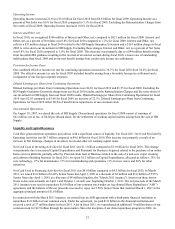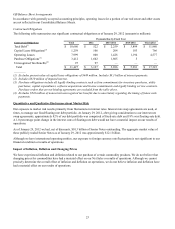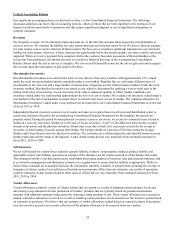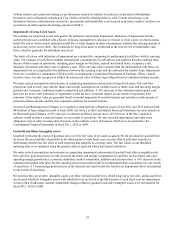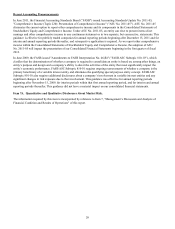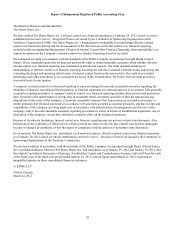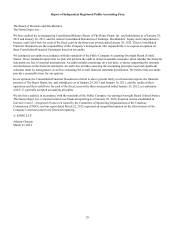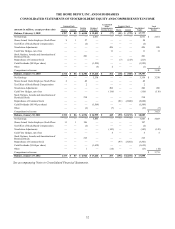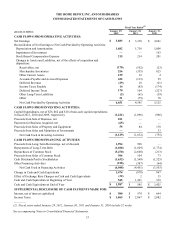Home Depot 2011 Annual Report Download - page 31
Download and view the complete annual report
Please find page 31 of the 2011 Home Depot annual report below. You can navigate through the pages in the report by either clicking on the pages listed below, or by using the keyword search tool below to find specific information within the annual report.
25
Volume rebates and certain advertising co-op allowances earned are initially recorded as a reduction in Merchandise
Inventories and a subsequent reduction in Cost of Sales when the related product is sold. Certain advertising co-op
allowances that are reimbursements of specific, incremental and identifiable costs incurred to promote vendors’ products are
recorded as an offset against advertising expense in SG&A.
Impairment of Long-Lived Assets
We evaluate our long-lived assets each quarter for indicators of potential impairment. Indicators of impairment include
current period losses combined with a history of losses, management’s decision to relocate or close a store or other location
before the end of its previously estimated useful life or when changes in other circumstances indicate the carrying amount of
an asset may not be recoverable. The evaluation for long-lived assets is performed at the lowest level of identifiable cash
flows, which is generally the individual store level.
The assets of a store with indicators of impairment are evaluated by comparing its undiscounted cash flows with its carrying
value. The estimate of cash flows includes management’s assumptions of cash inflows and outflows directly resulting from
the use of those assets in operations, including gross margin on Net Sales, payroll and related items, occupancy costs,
insurance allocations and other costs to operate a store. If the carrying value is greater than the undiscounted cash flows, an
impairment loss is recognized for the difference between the carrying value and the estimated fair market value. Impairment
losses are recorded as a component of SG&A in the accompanying Consolidated Statements of Earnings. When a leased
location closes, we also recognize in SG&A the net present value of future lease obligations less estimated sublease income.
We make critical assumptions and estimates in completing impairment assessments of long-lived assets. Our cash flow
projections look several years into the future and include assumptions on variables such as future sales and operating margin
growth rates, economic conditions, market competition and inflation. A 10% decrease in the estimated undiscounted cash
flows for the stores with indicators of impairment would not have a material impact on our results of operations. Our
estimates of fair market value are generally based on market appraisals of owned locations and estimates on the amount of
potential sublease income and the time required to sublease for leased locations.
As part of our Rationalization Charges, we recorded no material lease obligation costs in fiscal 2011 and 2010 and recorded
$84 million of lease obligation costs in fiscal 2009. See Note 2 to the Consolidated Financial Statements for more details on
the Rationalization Charges. A 10% decrease in estimated sublease income and a 10% increase in the time required to
sublease would not have a material impact on our results of operations. We also recorded impairments and other lease
obligation costs on other closings and relocations in the ordinary course of business, which were not material to the
Consolidated Financial Statements in fiscal 2011, 2010 or 2009.
Goodwill and Other Intangible Assets
Goodwill represents the excess of purchase price over the fair value of net assets acquired. We do not amortize goodwill but
do assess the recoverability of goodwill in the third quarter of each fiscal year, or more often if indicators warrant, by
determining whether the fair value of each reporting unit supports its carrying value. The fair values of our identified
reporting units were estimated using the present value of expected future discounted cash flows.
We make critical assumptions and estimates in completing impairment assessments of goodwill and other intangible assets.
Our cash flow projections look several years into the future and include assumptions on variables such as future sales and
operating margin growth rates, economic conditions, market competition, inflation and discount rates. A 10% decrease in the
estimated discounted cash flows for the reporting units tested would result in an impairment that is not material to our results
of operations. A 1.0 percentage point increase in the discount rate used would also result in an impairment that is not material
to our results of operations.
We amortize the cost of other intangible assets over their estimated useful lives, which range up to ten years, unless such lives
are deemed indefinite. Intangible assets with indefinite lives are tested in the third quarter of each fiscal year for impairment,
or more often if indicators warrant. Impairment charges related to goodwill and other intangible assets were not material for
fiscal 2011, 2010 or 2009.


